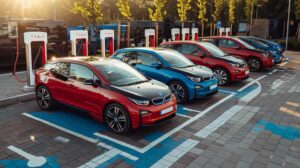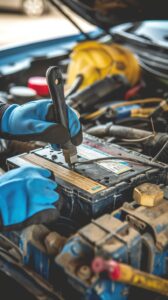Car Market Trends
The car market never stays the same; it is the function of technological innovation, changing customer preferences, and the altering dynamics of the regulatory framework. Thus, keeping up with trends in the present era is not only an imperative for the stakeholders but also for consumers. This paper discusses the trends in the car market for 2024, focusing on new innovations, market shifts, and emerging preferences.

Rise of Electric Vehicles
Increased Adoption and Sales
- Surging Demand: Electric vehicles see a steep demand, both on the backdrop of environmental awareness and government policies.
- Market Penetration: EVs will occupy a larger share of the market; projections show that, by the year 2030, they could make almost half of all new car sales.

Solid-State Batteries
- Next-Gen Batteries: Next-generation batteries promise a long range, faster recharging speed, and enhanced safety.
- Lower costs: coupled with continuous improvement in battery technology, are making EVs more affordable to many more consumers.

Expansion of Charging Infrastructure
- Rising Availability: Public and private charging stations are growing in number, thus making the use of an EV easier.
- Innovative Solutions: Wireless charging and ultrafast chargers are some of the technologies in development to further pave the way for electric mobility.

Growth of Autonomous Vehicles
Betterment of Self-Driving Technology
- Level 4 and 5 Autonomy: Autonomous vehicle technology is trending toward the higher levels of autonomy, with some capable of full self-driving in certain conditions.
- Testing and Deployment: Companies test autonomous vehicles more and more. Pilot programs for ride-hailing and delivery services are already in place.
Regulatory Support:
- Governmental Initiatives: Development of regulatory environments at the governmental level is taking place for the safe deployment of autonomous vehicles, which address requirements concerning safety and liability as well as infrastructure.
- Public Acceptance: Educating and building trust among people in the self-driving technology.

Connected Car Technology Integration
Smart Features and Connectivity
- IoT: Cars get more fitted with IoT capabilities that make automobiles functional through real-time data exchange.
- In-Car Services: Next-generation automobiles are becoming more standard, hosting sophisticated features such as navigation, remote diagnostics, and over-the-air updates.
Improved Safety and Convenience
- Driver Assistance Systems: Advances like Adaptive Cruise Control, Lane-Keeping Assist, and Automatic Emergency Braking make driving safer and more convenient.
- Personalization: Assured connected car technology for a more personal drive; one can have customization of settings and individual user preference.
Shift in Consumer Preference
Increasing Demand for SUVs and Crossovers
- Popularity Surge: SUVs and crossovers appear to be ruling the roost with attributes that make them versatile, roomy, and headily safe.
- Electric Variants: Electrification of SUVs and crossovers is now offering customers green alternatives without losing any of their practicality.
Greater Preference for Greener

More Eco-Friendly Options
- Greener Pastures: Environmental considerations dominate consumer purchase decisions where low impact is sought after in a vehicle.
- Hybrid and Electric Options: Hybrid and electric models quickly fill up the market to meet the demand of environment-conscious customers.
Emphasis on Green and Sustainable Solutions
Green Manufacturing
- Sustainable Production: The companies are rapidly shifting gears towards green productions, reusing the materials and promoting zero wastage of materials.
- Carbon Neutrality Goals: Challenging goals are being set by companies regarding the attainment of carbon neutrality in the process of manufacturing.

Recycling and Re-Use
- EV Battery Recycling: Efforts are being made to develop an effective EV battery recycling process.
- Circular Economy: The automotive sector seems to be gradually turning to a circular economy concept that focuses on reusing and recycling materials.
New Business Model Development

Subscription Services
- Flexibility and Convenience: Today, subscribing to cars is standard and allows customers to change the car whenever necessary, not being locked into a long-term agreement.
- Inclusive Packages: Insurance and maintenance costs get bundled together to deliver a seamless car ownership experience.
Shared Mobility Services/Car Sharing
- Urban Mobility Solutions: Car-sharing and ride-hailing services reduce urban mobility problems, thus making the need for personal cars to be owned unnecessary.
- Sustainable Transportation: These services facilitate sustainable transportation by increasing the vehicle utilization thereby reducing traffic congestion within cities.
Technological Advancements
ADAS—Advanced Driver Assistance Systems
- Improved Safety: The features of ADAS are getting sophisticated to provide improved safety through advanced blind spot monitoring and collision avoidance systems.
- Most of the features listed herein have already begun finding a place as standard in most new cars and are, therefore, making roads safe in general.
Infotainment and Connectivity
- Better User Experience: Infotainment systems are becoming smarter. phone and other device integration has become more seamless.
- Voice Control and AI: State-of-the-art voice control and artificial intelligence make it easier for drivers to interact safely with their vehicles.
Impact of Global Supply Chain Challenges
Semiconductor Shortages
- Production Delays: The global semiconductor shortage has delayed production and reduced inventory for many carmakers.
- Adaptation Strategies: Companies are thus adapting by diversifying the supply chain and increasing the focus on key parts.
Raw Material Costs
- Price Increases: Increasing costs of raw materials, like lithium and cobalt used in EV batteries, are raising vehicle prices.
- Sustainable Sourcing: So, automakers are seeking sustainable sourcing solutions to remove the effect of raw material cost fluctuations.
Conclusion
Dramatic change is sweeping through the car market, powered by technological innovation, shifting consumer preference, and pressing concerns for sustainability. From the introduction of electric and autonomous vehicles to the integration of connected car technology and new business models, the industry is developing to cater to a modern, eco-conscious world. In view of these trends, it becomes increasingly important to keep up with them for any consumer, professional in the field, or decision-maker who wants to navigate this dynamic automotive landscape with success.
Frequently Asked Questions
- What are some of the main trends expected in the car market during 2024?
Some of the key trends include growing adoption of electric vehicles, advanced autonomous driving technologies, connected car features, and ‘green’ sustainability.
-
How are consumer preferences changing in the car market?
There is a growing preference for SUVs/crossovers, ‘green’ and sustainable vehicle options, and flexible ownership models like car subscriptions.
- What does this mean for the car market?
Global supply chain challenges mean that production is delayed, and vehicle prices rise, through semiconductor shortages and increasing raw material costs.
- What place does connected car technology take in today’s car market?
Connected car technology adds smart features, improved safety systems, and user settings to the driving experience.
- How are new business models influencing the car market?
New business models of car subscription and car sharing services will offer flexible and sustainable transportation options that will, more seldom, require traditional car ownership.
